Hyundai Sonata Hybrid 2011 Owner's Manual
Manufacturer: HYUNDAI, Model Year: 2011, Model line: Sonata Hybrid, Model: Hyundai Sonata Hybrid 2011Pages: 404, PDF Size: 11.04 MB
Page 381 of 404
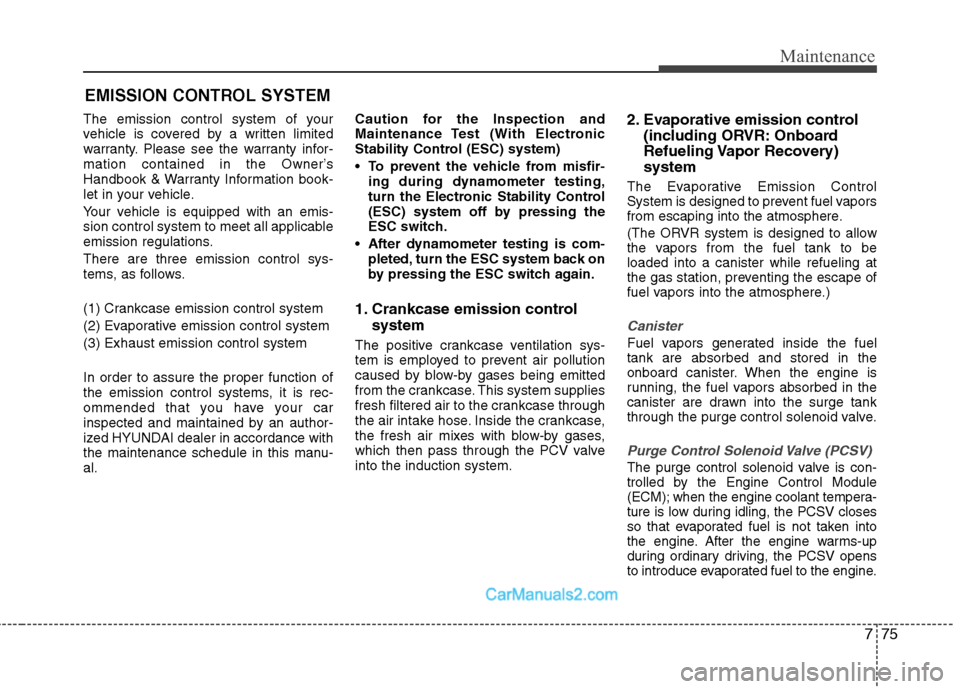
775
Maintenance
EMISSION CONTROL SYSTEM
The emission control system of your
vehicle is covered by a written limited
warranty. Please see the warranty infor-
mation contained in the Owner’s
Handbook & Warranty Information book-
let in your vehicle.
Your vehicle is equipped with an emis-
sion control system to meet all applicable
emission regulations.
There are three emission control sys-
tems, as follows.
(1) Crankcase emission control system
(2) Evaporative emission control system
(3) Exhaust emission control system
In order to assure the proper function of
the emission control systems, it is rec-
ommended that you have your car
inspected and maintained by an author-
ized HYUNDAI dealer in accordance with
the maintenance schedule in this manu-
al.Caution for the Inspection and
Maintenance Test (With Electronic
Stability Control (ESC) system)
To prevent the vehicle from misfir-
ing during dynamometer testing,
turn the Electronic Stability Control
(ESC) system off by pressing the
ESC switch.
After dynamometer testing is com-
pleted, turn the ESC system back on
by pressing the ESC switch again.
1. Crankcase emission control
system
The positive crankcase ventilation sys-
tem is employed to prevent air pollution
caused by blow-by gases being emitted
from the crankcase. This system supplies
fresh filtered air to the crankcase through
the air intake hose. Inside the crankcase,
the fresh air mixes with blow-by gases,
which then pass through the PCV valve
into the induction system.
2. Evaporative emission control
(including ORVR: Onboard
Refueling Vapor Recovery)
system
The Evaporative Emission Control
System is designed to prevent fuel vapors
from escaping into the atmosphere.
(The ORVR system is designed to allow
the vapors from the fuel tank to be
loaded into a canister while refueling at
the gas station, preventing the escape of
fuel vapors into the atmosphere.)
Canister
Fuel vapors generated inside the fuel
tank are absorbed and stored in the
onboard canister. When the engine is
running, the fuel vapors absorbed in the
canister are drawn into the surge tank
through the purge control solenoid valve.
Purge Control Solenoid Valve (PCSV)
The purge control solenoid valve is con-
trolled by the Engine Control Module
(ECM); when the engine coolant tempera-
ture is low during idling, the PCSV closes
so that evaporated fuel is not taken into
the engine. After the engine warms-up
during ordinary driving, the PCSV opens
to introduce evaporated fuel to the engine.
Page 382 of 404
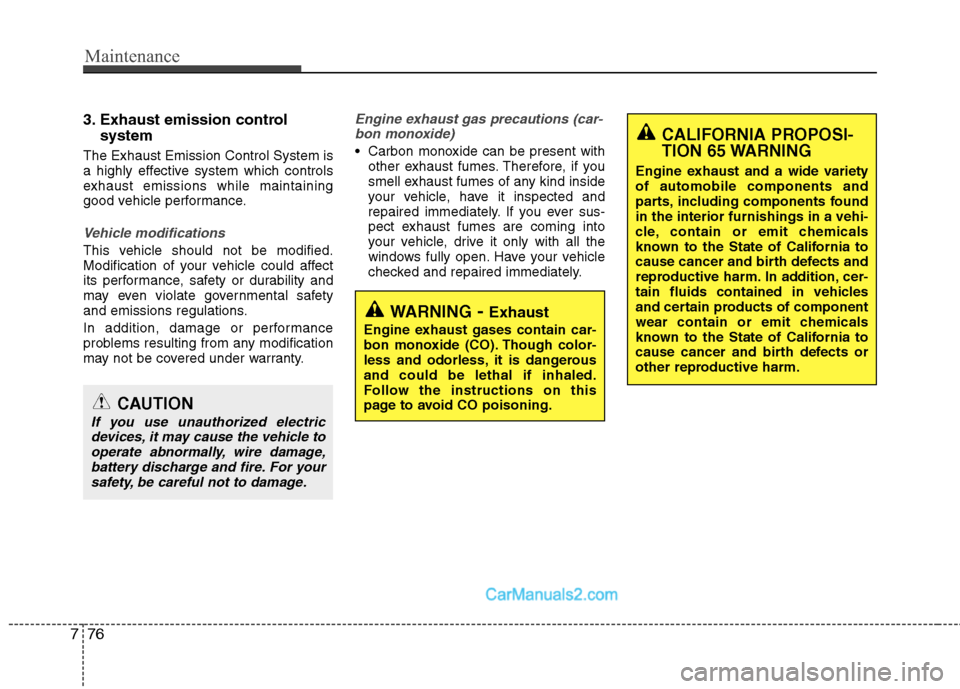
Maintenance
76 7
3. Exhaust emission control
system
The Exhaust Emission Control System is
a highly effective system which controls
exhaust emissions while maintaining
good vehicle performance.
Vehicle modifications
This vehicle should not be modified.
Modification of your vehicle could affect
its performance, safety or durability and
may even violate governmental safety
and emissions regulations.
In addition, damage or performance
problems resulting from any modification
may not be covered under warranty.
Engine exhaust gas precautions (car-
bon monoxide)
Carbon monoxide can be present with
other exhaust fumes. Therefore, if you
smell exhaust fumes of any kind inside
your vehicle, have it inspected and
repaired immediately. If you ever sus-
pect exhaust fumes are coming into
your vehicle, drive it only with all the
windows fully open. Have your vehicle
checked and repaired immediately.
WARNING- Exhaust
Engine exhaust gases contain car-
bon monoxide (CO). Though color-
less and odorless, it is dangerous
and could be lethal if inhaled.
Follow the instructions on this
page to avoid CO poisoning.
CALIFORNIA PROPOSI-
TION 65 WARNING
Engine exhaust and a wide variety
of automobile components and
parts, including components found
in the interior furnishings in a vehi-
cle, contain or emit chemicals
known to the State of California to
cause cancer and birth defects and
reproductive harm. In addition, cer-
tain fluids contained in vehicles
and certain products of component
wear contain or emit chemicals
known to the State of California to
cause cancer and birth defects or
other reproductive harm.
CAUTION
If you use unauthorized electric
devices, it may cause the vehicle to
operate abnormally, wire damage,
battery discharge and fire. For your
safety, be careful not to damage.
Page 383 of 404
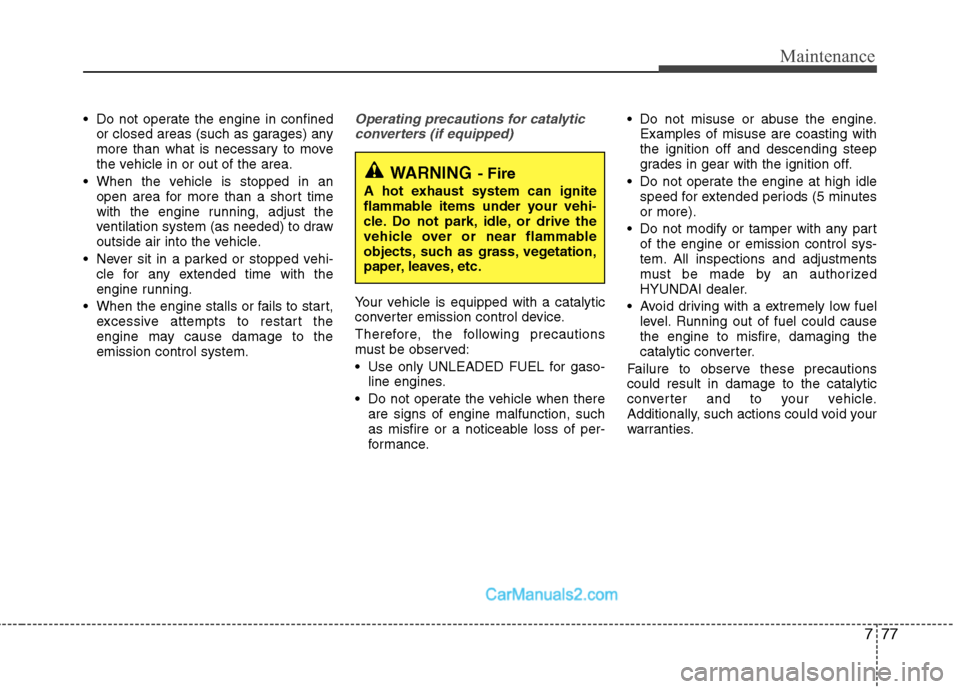
777
Maintenance
Do not operate the engine in confined
or closed areas (such as garages) any
more than what is necessary to move
the vehicle in or out of the area.
When the vehicle is stopped in an
open area for more than a short time
with the engine running, adjust the
ventilation system (as needed) to draw
outside air into the vehicle.
Never sit in a parked or stopped vehi-
cle for any extended time with the
engine running.
When the engine stalls or fails to start,
excessive attempts to restart the
engine may cause damage to the
emission control system.Operating precautions for catalytic
converters (if equipped)
Your vehicle is equipped with a catalytic
converter emission control device.
Therefore, the following precautions
must be observed:
Use only UNLEADED FUEL for gaso-
line engines.
Do not operate the vehicle when there
are signs of engine malfunction, such
as misfire or a noticeable loss of per-
formance. Do not misuse or abuse the engine.
Examples of misuse are coasting with
the ignition off and descending steep
grades in gear with the ignition off.
Do not operate the engine at high idle
speed for extended periods (5 minutes
or more).
Do not modify or tamper with any part
of the engine or emission control sys-
tem. All inspections and adjustments
must be made by an authorized
HYUNDAI dealer.
Avoid driving with a extremely low fuel
level. Running out of fuel could cause
the engine to misfire, damaging the
catalytic converter.
Failure to observe these precautions
could result in damage to the catalytic
converter and to your vehicle.
Additionally, such actions could void your
warranties.
WARNING- Fire
A hot exhaust system can ignite
flammable items under your vehi-
cle. Do not park, idle, or drive the
vehicle over or near flammable
objects, such as grass, vegetation,
paper, leaves, etc.
Page 384 of 404
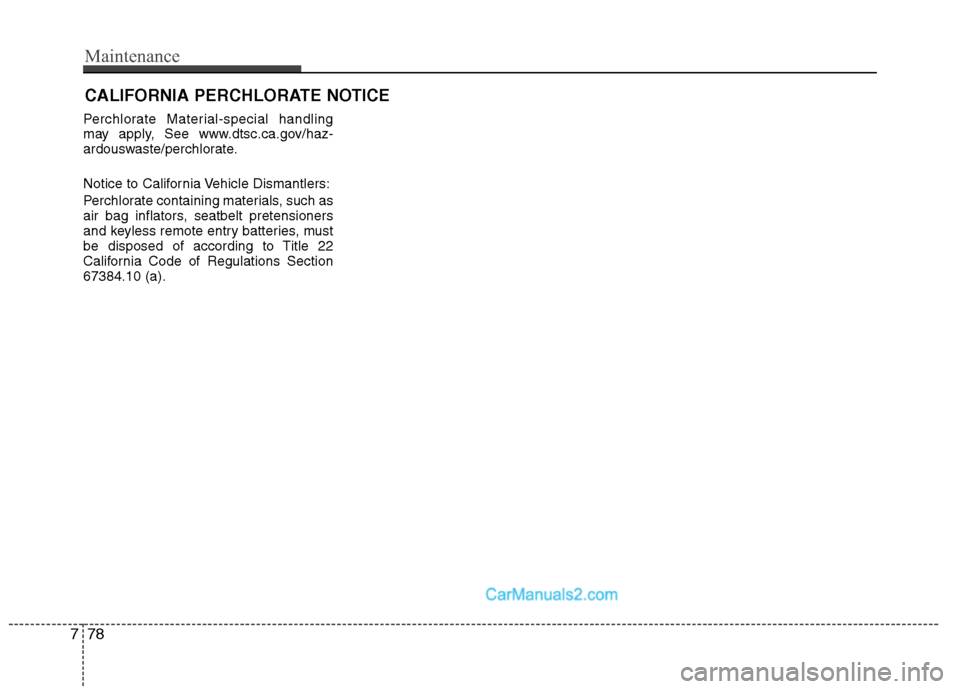
CALIFORNIA PERCHLORATE NOTICE
Perchlorate Material-special handling
may apply, See www.dtsc.ca.gov/haz-
ardouswaste/perchlorate.
Notice to California Vehicle Dismantlers:
Perchlorate containing materials, such as
air bag inflators, seatbelt pretensioners
and keyless remote entry batteries, must
be disposed of according to Title 22
California Code of Regulations Section
67384.10 (a).
778
Maintenance
Page 385 of 404
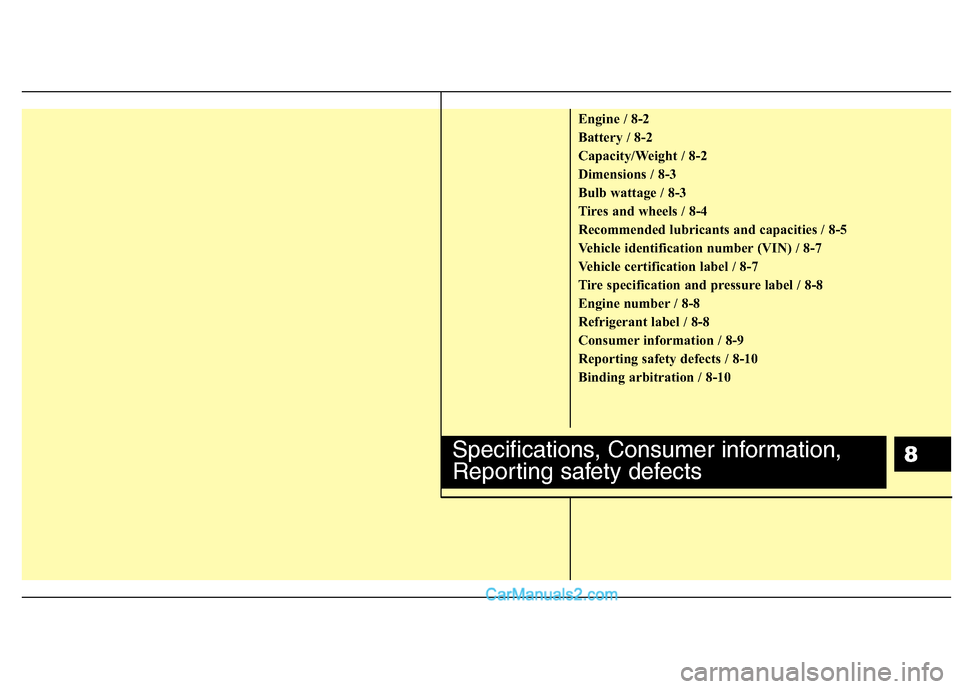
8
Engine / 8-2
Battery / 8-2
Capacity/Weight / 8-2
Dimensions / 8-3
Bulb wattage / 8-3
Tires and wheels / 8-4
Recommended lubricants and capacities / 8-5
Vehicle identification number (VIN) / 8-7
Vehicle certification label / 8-7
Tire specification and pressure label / 8-8
Engine number / 8-8
Refrigerant label / 8-8
Consumer information / 8-9
Reporting safety defects / 8-10
Binding arbitration / 8-10
Specifications, Consumer information,
Reporting safety defects
Page 386 of 404
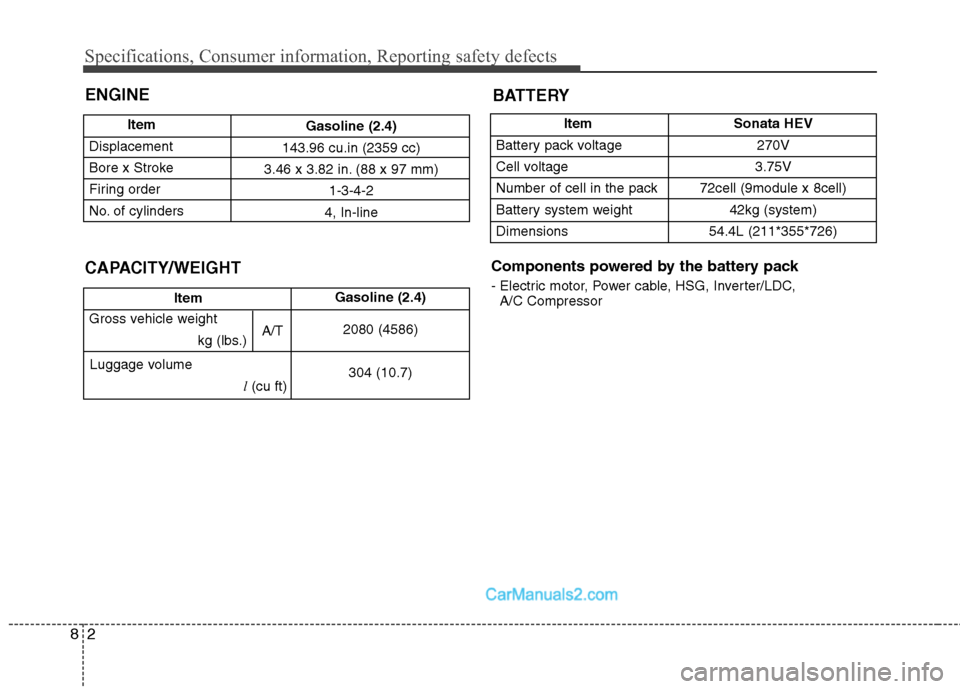
Specifications, Consumer information, Reporting safety defects
2 8
CAPACITY/WEIGHT
Item
Displacement
Bore x Stroke
Firing order
No. of cylindersGasoline (2.4)
143.96 cu.in (2359 cc)
3.46 x 3.82 in. (88 x 97 mm)
1-3-4-2
4, In-line
ENGINE
BATTERY
Gross vehicle weight
kg (lbs.)Gasoline (2.4)
2080 (4586)
304 (10.7) Item
Luggage volume
l(cu ft)A/T
Item
Battery pack voltage
Cell voltage
Number of cell in the pack
Battery system weight
DimensionsSonata HEV
270V
3.75V
72cell (9module x 8cell)
42kg (system)
54.4L (211*355*726)
Components powered by the battery pack
- Electric motor, Power cable, HSG, Inverter/LDC,
A/C Compressor
Page 387 of 404
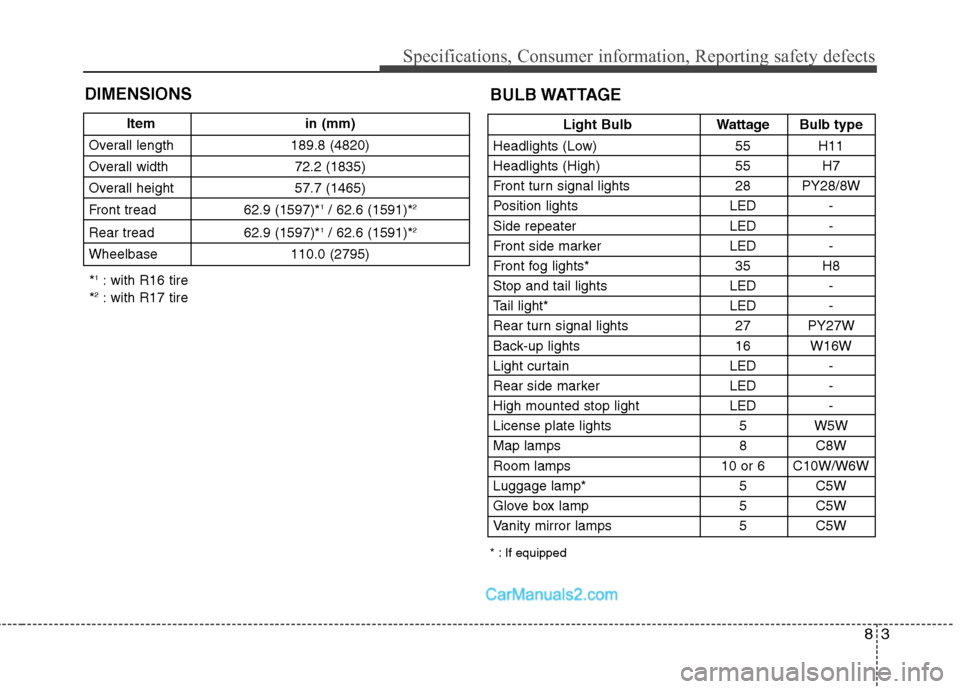
83
Specifications, Consumer information, Reporting safety defects
DIMENSIONS
Light Bulb Wattage Bulb type
Headlights (Low) 55 H11
Headlights (High) 55 H7
Front turn signal lights 28 PY28/8W
Position lights LED -
Side repeater LED -
Front side marker LED -
Front fog lights* 35 H8
Stop and tail lights LED -
Tail light* LED -
Rear turn signal lights 27 PY27W
Back-up lights 16 W16W
Light curtain LED -
Rear side marker LED -
High mounted stop light LED -
License plate lights 5 W5W
Map lamps 8 C8W
Room lamps 10 or 6 C10W/W6W
Luggage lamp* 5 C5W
Glove box lamp 5 C5W
Vanity mirror lamps 5 C5W
BULB WATTAGE
* : If equipped
Item in (mm)
Overall length 189.8 (4820)
Overall width 72.2 (1835)
Overall height 57.7 (1465)
Front tread 62.9 (1597)*
1/ 62.6 (1591)*2
Rear tread 62.9 (1597)*1/ 62.6 (1591)*2
Wheelbase 110.0 (2795)
*1: with R16 tire
*2: with R17 tire
Page 388 of 404
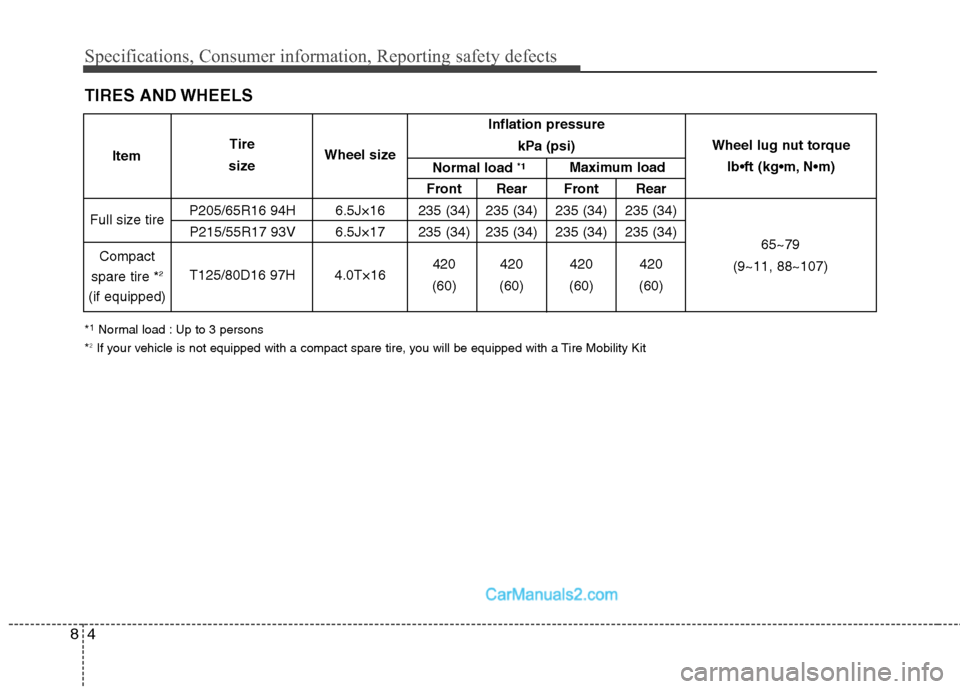
Specifications, Consumer information, Reporting safety defects
4 8
TIRES AND WHEELS
*1Normal load : Up to 3 persons
*2If your vehicle is not equipped with a compact spare tire, you will be equipped with a Tire Mobility Kit
Inflation pressure
kPa (psi)
Front Rear Front Rear
P205/65R16 94H 6.5J×16 235 (34) 235 (34) 235 (34) 235 (34)
P215/55R17 93V 6.5J×17 235 (34) 235 (34) 235 (34) 235 (34)
420 420 420 420
T125/80D16 97H 4.0T×16
(60) (60) (60) (60)
Full size tire
Compact
spare tire *
2
(if equipped)Wheel lug nut torque
lb•ft (kg N
65~79
(9~11, 88~107) ItemTire
sizeWheel size
Normal load
*1Maximum load
Page 389 of 404
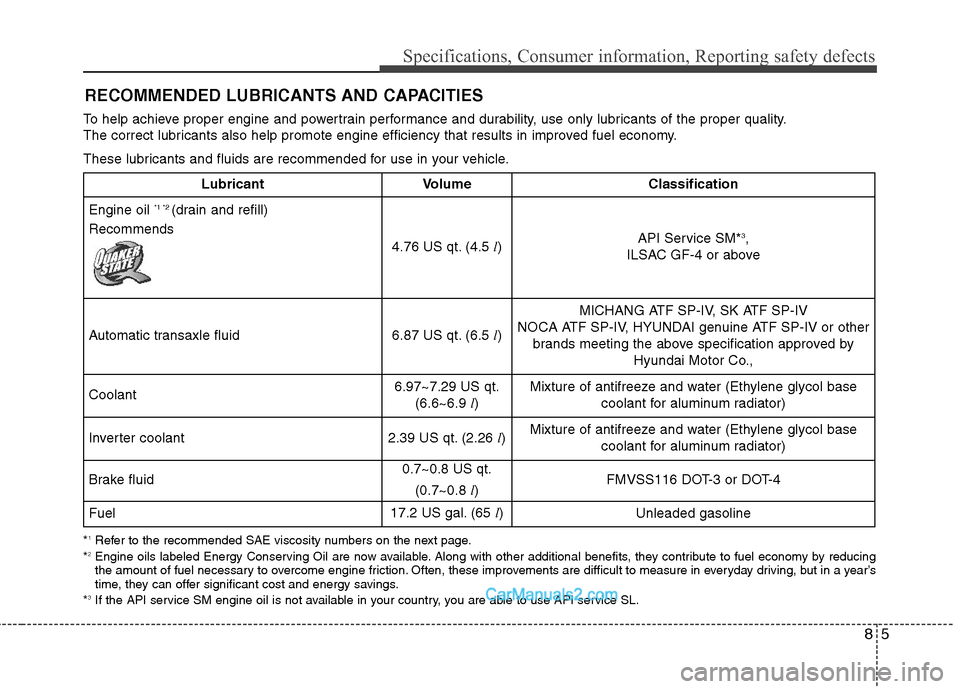
85
Specifications, Consumer information, Reporting safety defects
RECOMMENDED LUBRICANTS AND CAPACITIES
To help achieve proper engine and powertrain performance and durability, use only lubricants of the proper quality.
The correct lubricants also help promote engine efficiency that results in improved fuel economy.
These lubricants and fluids are recommended for use in your vehicle.
*1Refer to the recommended SAE viscosity numbers on the next page.
*2Engine oils labeled Energy Conserving Oil are now available. Along with other additional benefits, they contribute to fuel economy by reducing
the amount of fuel necessary to overcome engine friction. Often, these improvements are difficult to measure in everyday driving, but in a year’s
time, they can offer significant cost and energy savings.
*
3If the API service SM engine oil is not available in your country, you are able to use API service SL.
LubricantVolumeClassification
Engine oil *1 *2 (drain and refill)
Recommends
4.76 US qt. (4.5 l)API Service SM*3,
ILSAC GF-4 or above
Automatic transaxle fluid6.87 US qt. (6.5 l)
MICHANG ATF SP-IV, SK ATF SP-IV
NOCA ATF SP-IV, HYUNDAI genuine ATF SP-IV or other
brands meeting the above specification approved by
Hyundai Motor Co.,
Coolant 6.97~7.29 US qt.
(6.6~6.9 l)Mixture of antifreeze and water (Ethylene glycol base
coolant for aluminum radiator)
Inverter coolant2.39 US qt. (2.26 l)Mixture of antifreeze and water (Ethylene glycol base
coolant for aluminum radiator)
Brake fluid0.7~0.8 US qt.
(0.7~0.8 l)FMVSS116 DOT-3 or DOT-4
Fuel17.2 US gal. (65 l)Unleaded gasoline
Page 390 of 404
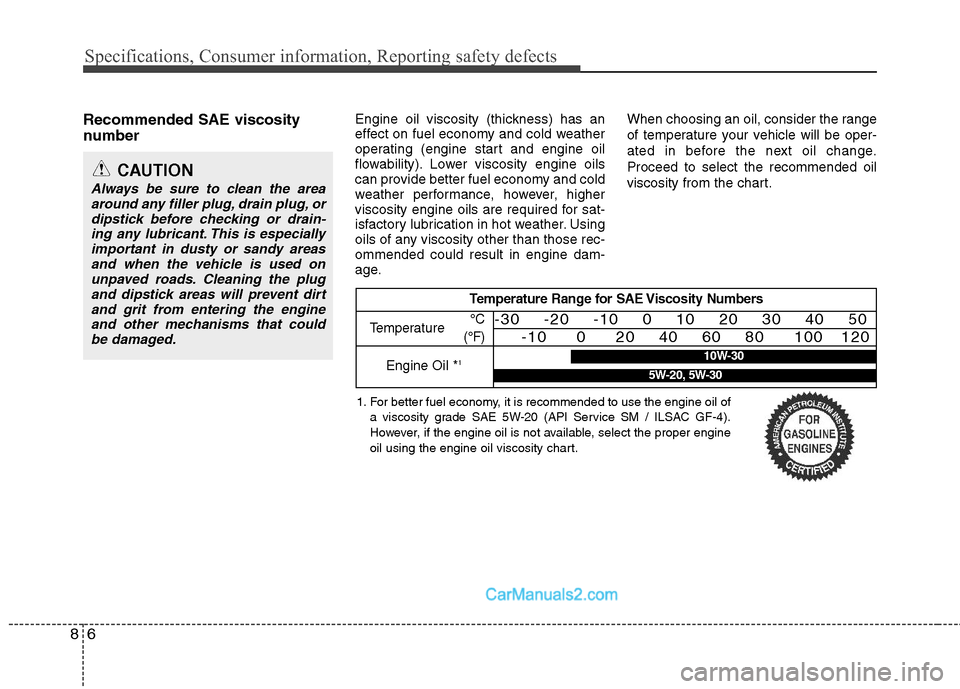
Specifications, Consumer information, Reporting safety defects
6 8
Recommended SAE viscosity
number Engine oil viscosity (thickness) has an
effect on fuel economy and cold weather
operating (engine start and engine oil
flowability). Lower viscosity engine oils
can provide better fuel economy and cold
weather performance, however, higher
viscosity engine oils are required for sat-
isfactory lubrication in hot weather. Using
oils of any viscosity other than those rec-
ommended could result in engine dam-
age.When choosing an oil, consider the range
of temperature your vehicle will be oper-
ated in before the next oil change.
Proceed to select the recommended oil
viscosity from the chart.
CAUTION
Always be sure to clean the area
around any filler plug, drain plug, or
dipstick before checking or drain-
ing any lubricant. This is especially
important in dusty or sandy areas
and when the vehicle is used on
unpaved roads. Cleaning the plug
and dipstick areas will prevent dirt
and grit from entering the engine
and other mechanisms that could
be damaged.
Temperature Range for SAE Viscosity Numbers
Temperature
Engine Oil *
1
°C
(°F)-30 -20 -10 0 10 20 30 40 50
-10 0 20 40 60 80 100 120
1. For better fuel economy, it is recommended to use the engine oil of
a viscosity grade SAE 5W-20 (API Service SM / ILSAC GF-4).
However, if the engine oil is not available, select the proper engine
oil using the engine oil viscosity chart.
10W-30
5W-20, 5W-30